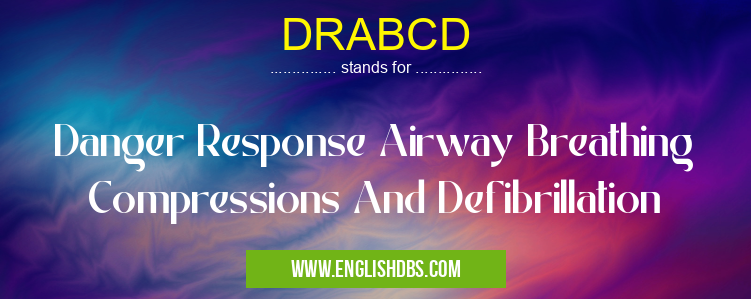What does DRABCD mean in UNCLASSIFIED
DRABCD is an acronym used to assist with remembering important steps for providing initial care during a medical emergency. It stands for Danger Response Airway Breathing Compressions And Defibrillation. By understanding the basics of what this acronym means and how to apply it, you can help ensure that people in need get the best care possible in the most efficient way possible.

DRABCD meaning in Unclassified in Miscellaneous
DRABCD mostly used in an acronym Unclassified in Category Miscellaneous that means Danger Response Airway Breathing Compressions And Defibrillation
Shorthand: DRABCD,
Full Form: Danger Response Airway Breathing Compressions And Defibrillation
For more information of "Danger Response Airway Breathing Compressions And Defibrillation", see the section below.
Danger
The first step when approaching any potential medical emergency situation is to assess the danger of the environment and take actions accordingly. If there is imminent danger, for yourself or for the individual requiring treatment, then you should consider whether or not you should call for help from professionals such as paramedics or police. Depending on the scenario, that may be your safest course of action.
Response
Once you have assessed whether there is immediate danger and acted accordingly, it is important to check how responsive an individual is after a medical incident has occurred. This means checking if they are conscious and responding verbally or physically when spoken to or shown different stimuli (for example, a painful stimulus such as pinching their skin). If they do not respond in any way at all, then they may require more advanced treatment before other steps are taken.
Airway
Ensuring a clear airway is essential when providing any type of initial response care. This means making sure that nothing such as vomit, food debris, fluids, or even dentures are blocking the person's airway so they can breathe properly. If there is something obstructing their airway then it should be removed immediately and reassuringly so that airflow can be restored safely and effectively.
Breathing
If an individual has been found to be unresponsive but with a clear airway then establishing if they are still breathing should be your next priority. To do this efficiently and accurately you should look out for chest rise/fall movements rather than solely relying on listening or feeling for breathing; this will give you the clearest indication of whether respiration has been permanently compromised.
Compressions
If there is no evidence of natural respiration then commencing immediate chest compressions will provide essential life-saving support until professional medical assistance arrives onsite. Chest compressions use rhythmic pressure applied directly over the heart chamber which can progressively circulate oxygen-rich blood throughout the body until normal respiration resumes itself naturally.
Defibrillation
The last step listed in DRABCD - defibrillation - involves using an automated external defibrillator (AED) device which can emit electric shocks (in specific amounts decided by qualified medical personnel) through two pads placed onto either side of the chest area which aims to restart an abnormal heartbeat rhythm back into its correct pattern. This process must only ever be carried out following strict protocols provided with AED devices and where authorized trained personnel provides oversight.
Essential Questions and Answers on Danger Response Airway Breathing Compressions And Defibrillation in "MISCELLANEOUS»UNFILED"
What is DRABCD?
DRABCD stands for Danger Response Airway Breathing Compressions And Defibrillation. It is a lifesaving algorithm that outlines the first steps to take when responding to an emergency medical situation.
What type of situations warrant using the DRABCD algorithm?
The DRABCD algorithm should be used in any situation where a person may be experiencing cardiac arrest or other life-threatening medical emergency.
Where can I find information on how to perform the various components of the DRABCD protocol?
Information regarding how to perform effective airway management, breathing support, chest compressions and defibrillation can be found from certified healthcare providers and online resources.
How soon after arrival should I start performing CPR according to the DRABCD protocol?
If you arrive at the scene of an emergency and find a person unresponsive and not breathing, you should immediately begin performing CPR following the DRABCD protocol.
What is the correct ordering of steps when following the DRABCD protocol?
The correct ordering of steps for following the DRABCD algorithm are danger response, airway, breathing, chest compressions and defibrillation.
Is it necessary to stop performing CPR during defibrillation when using the DRABCD protocol?
Yes, it is important to stop performing chest compressions while delivering a shock during defibrillation according to the DRABCD protocol.
Does everyone require a different approach to usingthetheDR ABCDE Protocol?
While each individual may require different care depending on their medical condition and needs, all individuals can benefit from following the same basic steps outlined in the DR ABCDE Protocol.
Final Words:
In summary, DRABCD stands as an easy-to-use acronym which serves as an invaluable reminder of both practical steps as well as necessary safety considerations required when first aiding someone during a medical emergency situation. By familiarizing yourself with these guidelines now you'll have peace of mind knowing that your preparedness could one day save someone's life!
